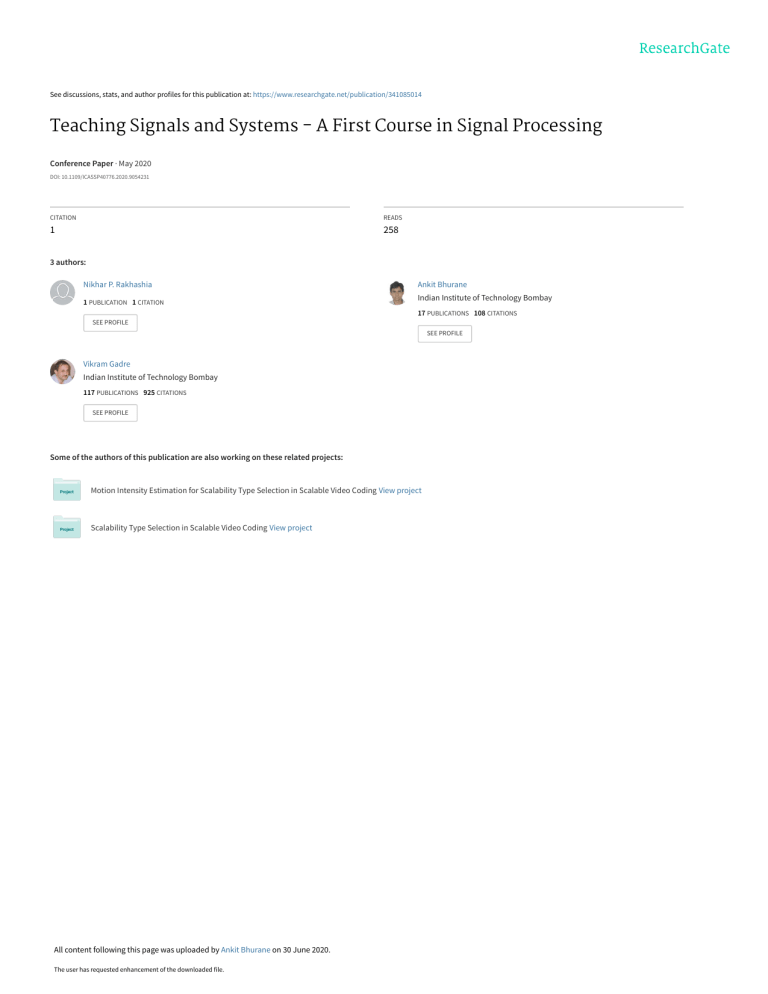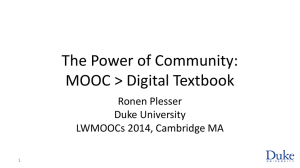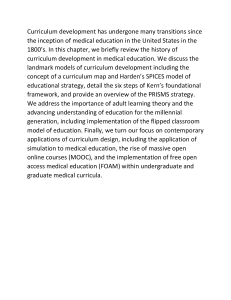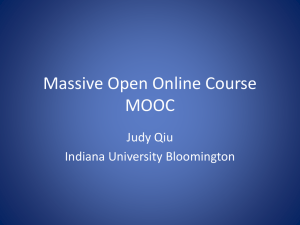
See discussions, stats, and author profiles for this publication at: https://www.researchgate.net/publication/341085014 Teaching Signals and Systems - A First Course in Signal Processing Conference Paper · May 2020 DOI: 10.1109/ICASSP40776.2020.9054231 CITATION READS 1 258 3 authors: Nikhar P. Rakhashia 1 PUBLICATION 1 CITATION Ankit Bhurane Indian Institute of Technology Bombay 17 PUBLICATIONS 108 CITATIONS SEE PROFILE SEE PROFILE Vikram Gadre Indian Institute of Technology Bombay 117 PUBLICATIONS 925 CITATIONS SEE PROFILE Some of the authors of this publication are also working on these related projects: Motion Intensity Estimation for Scalability Type Selection in Scalable Video Coding View project Scalability Type Selection in Scalable Video Coding View project All content following this page was uploaded by Ankit Bhurane on 30 June 2020. The user has requested enhancement of the downloaded file. TEACHING SIGNALS AND SYSTEMS - A FIRST COURSE IN SIGNAL PROCESSING Nikhar P. Rakhashia ? Ankit A. Bhurane † Vikram M. Gadre ? ? † Indian Institute of Technology Bombay Indian Institute of Information Technology Nagpur ABSTRACT Signals and systems is a well known fundamental course in signal processing. How this course is taught to a student can spell the difference between whether s/he pursues a career in this field or not. Giving due consideration to this matter, this paper reflects on the experiences in teaching this course. In addition, the authors share the experiences of creating and conducting a Massive Open Online Course (MOOC) on this subject under edX and subsequently following it up with deliberation among some students who did this course through the platform. Further, this paper emphasizes on various active learning techniques and modes of evaluation to ensure effective and holistic learning of the course. Index Terms— Signals and Systems, Massive Open Online Course (MOOC), Active learning 1. INTRODUCTION The course on signals and systems primarily not only builds the fundamentals for advanced courses such as digital signal processing, adaptive signal processing, wavelets and multirate signal processing, but also acts as an essential tool in various engineering fields like electrical, mechanical, chemical, aerospace etc. A heuristic understanding of mathematics and the underlying physical interpretation helps to retain curiosity and appreciate importance of the course. Teachinglearning methods have evolved with advancements in technology. With easy access to internet through mobile phones and other electronic gadgets, students quickly learn from online resources. An instructor should take advantage of this digital revolution and should structure and mould the instructions in such a way that students get attracted to learn. While the ease of access through MOOC encourages active learning, the classroom environment, live discussions and laboratory sessions are essentially more important in the course. In this paper, authors share the experiences of delivering a flipped We hereby gratefully acknowledge the support received, from the ‘Knowledge Incubation Under TEQIP-III’ Project at IIT Bombay (TEQIPIII-KITE at IIT Bombay) for the academic work related to this paper. Further, we gratefully acknowledge the Bharti Centre for Communication in the Department of Electrical Engineering, IIT Bombay and IEEE Signal Processing Society for financial support to attend and present this paper. 978-1-5090-6631-5/20/$31.00 ©2020 IEEE classroom mode of instruction [1] as well as creating and conducting MOOC on “Signals and Systems” under edX. 2. ACTIVE LEARNING APPROACHES The two main widely accepted active learning based approaches of instructions are as follows: a modern flipped classroom approach for a typical strength of 50 to 70 students and a MOOC based approach to reach masses through geographical outreach. These modes of instruction largely depend upon pre-lecture structure followed by in-class evaluation, post-lecture testing and content adaptation. Further, it requires precisely and strategically recorded quality instructional videos and active teaching associates [2]. 2.1. Modern Classroom Teaching The classroom teaching helps to stimulate critical thinking by bringing active and collaborative environment, thus making it the best way to learn the course. With the advances in technology, a typical modern classroom teaching relies on a blended approach of instructions. The course is pre-recorded in the form of short duration video lectures that focus on core content of the course [3]. A video lecture is released prior to the regular scheduled live lecture. The recorded lectures enhance the curiosity for interaction, discussions and group activities that are followed in the classroom. The lecture starts with a recapitulation of the concepts presented in video lectures and is supported by classroom activities. Numerical and hands-on sessions in the classroom, together with classroom teaching help the instructor to attend to the students in person, address their queries, and help them in filling up subtle conceptual gaps. 2.2. Active Learning through MOOC To reach mass audiences, MOOC based platforms like NPTEL, edX, and Coursera have marked their popularity in last few years with classroom teaching traits successfully exhibited. The MOOC lectures depict peer-to-peer learning as well as the instructor responding to questions/doubts of the students. During the lecture, the instructor poses challenging questions and encourages the students to post solutions on 9224 ICASSP 2020 Authorized licensed use limited to: University of Exeter. Downloaded on June 16,2020 at 12:01:25 UTC from IEEE Xplore. Restrictions apply. • Manipulation: Sketch and perform operations on different types of signals in both the domains. the course discussion forum. Periodically, instructor observes and responds to the discussion forum wherein he addresses doubts raised by the students. Thus, the feedback is obtained about how well students are doing with the course content which helps in adapting the flow of instruction. The lecture notes corresponding to each video are made available in the form of handouts. Some of the video lectures also depict the laboratory sessions for the students to get acquainted with the practical concepts of course. • Analysis: Analyze signals and systems by applying appropriate transformation techniques and relate them in time and frequency domain. • Comparison: Compare analogous continuous-time (CT) and discrete-time (DT) operations. • Applications: Apply and demonstrate the techniques for signal processing and communication systems. 2.3. Students’ perspective on modern classroom learning • How confident do you feel about the content after you watch the videos / animations ? It was found that more than 80% of students watched the videos before the class. More than 90% of students found the pre-class recapitulations, visualizations and discussions extremely useful. Around 80% of them felt confident and were curious to know more about the content after watching the videos and animations. These statistics show the effectiveness of the blended approach of instructions for the course, and at the same time emphasize the importance of an instructor in a live classroom. r Pe CTFS DTFS ic • Do you find the recapitulation / discussions at the beginning of class helpful? iod iod • Do you watch videos regularly on time? The MOOC on Signals and Systems offered by the Indian Institute of Technology Bombay is in two parts namely EE 210.1x and EE 210.2x [6],[7]. EE 210.1x covers topics such as introducing and formalising signals and systems, Linear Time Invariant (LTI) systems and the Fourier Transform (FT). EE 210.2x covers topics such as sampling and reconstruction, Discrete Time Fourier Transform (DTFT), Laplace Transform, Z-Transform and system analysis in generalised transform domain. An overview of the memory map of a student’s perspective of interconnection between various tools and domains is shown in Figure 1. ic Pe r In order to know the grasp of course instructions, a questionnaire was conducted in a class of 70 students at the Indian Institute of Information Technology Nagpur, to know their views about the mode of instruction. The questionnaire consisted of the following questions: c Sampling N on -P er N on - Pe r io di LPF CTFT di c DTFT LPF LT io ZT 3. MOOC ON SIGNALS AND SYSTEMS Since the target audience in any MOOC ranges from beginners to professionals, it is important to plan the MOOC accordingly to make it useful and relevant for diverse participants. In MOOC, the course is recorded in the form of video lectures divided into different modules. An empirical study of video production [4] states that shorter videos are more engaging. Hence, the duration of videos in a MOOC is normally 5 to 10 minutes. The most important challenge facing any MOOC is the high dropout rates of participants from the midst of the course [5]. Proper care needs to be taken while designing the course to reduce dropout rates. The course on signals and systems is a blend of mathematical tools and engineering concepts, and thus both aspects need to be covered in the course. The prerequisites for the course are the basic understanding of complex theory and calculus. The course usually comprises two main parts: natural (time) domain analysis and transform (frequency) domain analysis. By the end of the course, a student should be able to perform the following: DFT Fig. 1: An overview of interconnection between various domain transformation tools. 4. EMPHASIZING FUNDAMENTAL CONCEPTS Irrespective of the platform chosen, the course should help students answer the following fundamental questions: • Why is a domain transformation required? • What is the need of complex analysis in the real world? Why are complex exponentials used as a basis? • Why are different transformation techniques required? • How does the abstraction of systems help in addressing signal processing problems? What are the applications of LTI and non-LTI systems? 9225 Authorized licensed use limited to: University of Exeter. Downloaded on June 16,2020 at 12:01:25 UTC from IEEE Xplore. Restrictions apply. 4.1. Parallel treatment of CT and DT analysis Students usually find it difficult to interpret and deal with the domain transformations. For the same, it is instructed that CT and DT signals and systems be treated in parallel. While most of the times the representation is similar and straightforward, it is essential to emphasize the difference between continuous and discrete frequency variables. For example, the range of frequency variable is bounded in discrete domain as compared to continuous domain where it is infinite. Similarly, as opposed to the CT Fourier Series, the DT Fourier Series does not face the problem of convergence. The spectrum of sampled signals differs for the continuous and discrete case. All such differences are very essential to be noted and can be emphasised by covering the CT and DT transformation tools in parallel. This would also help the students to identify and apply appropriate tools as per scenario given and bridge the concepts in both the domains. It is essential to cover the concept of discretization of signals in the initial few classes. 4.2. Core Concepts Convolution being a core concept in this course should be presented with several analogous examples and visualizations. The mathematics behind it and functional interpretation should be derived and several examples should be extensively practiced both graphically and analytically. The concept of sampling introduced with respect to time domain can be revisited in the transform domain in order to relate the operations in both the domains. As most of the properties for domain transformation are analogous in nature, they should be critically compared with the properties of other transformations. In that way, the students get a broader picture of all the transformation tools and their properties. Further, the concept of duality property of transform helps the students to interpret the analogy between natural and transform domain. 5. VISUALS AND ANIMATIONS Animations are extremely helpful in visualizing the underlying concepts. For instance, visualizing a normal exponential could be trivial, however, visualizing a complex exponential could be difficult and can be explained with the help of a 3D animation of a rotating vector with its projection on real and lateral (imaginary) axis. The reconstruction of a signal using Fouries series components, and Gibbs’ phenomenon can be demonstrated using an illustration [8]. For another instance, convincing students that signals can be represented in terms of complex exponentials would be difficult without an appropriate visualization [9]. Further, the aliasing effect can be demonstrated by relating it to the wagon-wheel effect, whereas the importance of the phase in practice can be demonstrated with the help of two images by retaining the magnitude spectrum and exchanging phases [10]. An example of the illustrations is shown in Figure 2. Fig. 2: Fouries series synthesis using scaled complex exponentials, mapping rotating vectors on real and imaginary axis, example of convolution operation These visuals can be generated through numerical computational software. While most of the institutions rely on professional computing platforms like M ATLAB [11], a large community has started to explore alternate open-source platforms like GNU Octave, Scilab, and Python [12] mainly due to two reasons: free availability and large community support. Further, these open-source software have several libraries that can be readily utilised for laboratory sessions as well as advanced research projects. 6. LABORATORY SESSIONS, COURSE PROJECTS, AND COMMUNITY NETWORKING Laboratory is an essential component of this course and should go in parallel with the theory. The initial laboratory sessions of this course usually focus on the basic signal operations along independent and dependent variables. The laboratory task here could be a simple activity of recording one’s own voice followed by plotting and hearing it. This would help students get the physical interpretation of different signal operations. For example, scaling along the dependent axis refers to amplification or attenuation, and scaling along the independent axis refers to slower or faster playback. This 9226 Authorized licensed use limited to: University of Exeter. Downloaded on June 16,2020 at 12:01:25 UTC from IEEE Xplore. Restrictions apply. is how students can appreciate and relate the operations implemented at the back end of a music player. Further, this would not only give a feel of dealing with real-life signals but would also help in enhancing curiosity about the new terms like mono / stereo channels, and sampling frequency. It is instructed to have a significant weight for course projects that can be executed by a group of 3 to 5 students, preferably from varied disciplines, where they work on hardware or software platforms of their choice. The course itself has become largely interdisciplinary, thus covering large number of research areas. A student from computer sciences may opt for building a music equalizer or photo editing application using cloud platforms. A student from aeronautical sciences can take a project based on simulation, calibration and optimization of various aerodynamic models and signaling techniques. A biomedical engineering student may consider working on the development and analysis of systems for diagnosis of various human diseases using machine learning tools. Collaborating the students from varied disciplines boosts the active involvement and knowledge sharing. For example, a project to build a device that monitors vein beats can be taken by students from branches like electronics, computer science and biomedical engineering. They can contribute in circuit development, application interfacing, and data interpretation respectively and collaboratively. Moreover, the students can be encouraged to collaborate with doctoral candidates, where the latter can assign small problem tasks to the former. This would not only help the students to be in pace with the current research trends, but also escalate research progress. An additional component of research know-how can be added in the evaluation where a group of students critically present their understanding of a relevant research paper in the area of signal processing. The research papers can be identified from top conferences and journals like ICASSP, ICIP, GlobalSIP, SPCOM, etc. available on popular indexing platforms like IEEE Xplore, Elsevier Science-direct, Springer or on social platforms like Research Gate, Academia or Mendeley. Further, an instructor may also make students aware of various trusted online Question and Answer communities like DSP Stack Exchange [13] and Stack Overflow [14]. The collaboration can be extended by approaching local industries, medical institutes, and other relevant organizations so that the students get hands-on opportunities to work on live projects and instruments. Such collaboration helps in reducing the industry-academia gaps. 7. EVALUATION AND BEYOND THE COURSE A typical evaluation in this course should take into consideration holistic learning of students by appropriately reserving points for theory, laboratory, and research awareness. Some innovative methods are listed in [15]. Apart from a typical evaluation pattern, a provision for special points (around 10 − 20% of the total weight) gives the instructor an additional flexibility that can be utilized for encouraging students to take up theory or laboratory challenges. The continuous assessments not only ensure the evaluation based on recently covered topic, but also help the instructor to keep track of the student’s progress. This may include pre-laboratory or prelecture assessment. While summative assessment evaluates students on the basis of examinations, the formative assessment evaluates the students on the basis of projects, assignments and academic participation [16]. We suggest the evaluation procedure that focuses on both summative and formative assessments through two types of assessment scores: saturated and unsaturated. In a saturated grading scheme, the academic participation marks are limited, whereas in an unsaturated grading scheme, the students can earn any number of marks in the participation component without a limit. The saturated score focuses on summative assessment and gives more weight to the examination component. On the other hand, the unsaturated score focuses more on the formative assessment giving more weight to research and development as well as creativity component. Accordingly, saturated and unsaturated scores are computed for every student, from which a relatively better score is awarded to the student. This ensures the balance between the formative and summative assessment schemes. The course may be concluded by giving a glimpse of limitations of domain transformation tools learnt in the course. For example, one of the limitations of Fourier Analysis that can be emphasised is the inability to distinguish time-varying frequency components. The students can therefore be encouraged to explore time-frequency methods such as short-time Fourier Transform. This way, the curiosity of learning new tools can be raised. The new principles can be demonstrated analytically as well as through simulations. For instance, from the concepts of sampling and band-pass filters, students can be encouraged to design reconstruction filter banks. 8. CONCLUSION The course on signals and systems is extremely useful irrespective of the disciplines of engineering. The concepts and tools covered in this course find numerous applications and act as basic building blocks for analysis and synthesis of systems found in a variety of fields. The teaching of this course should take into consideration the holistic approach of learning by focusing on laboratory sessions, projects and research components along with the theoretical aspects. This paper expresses the authors’ thoughts and experience in both classroom based and MOOC based teaching. Further, the role of abstraction, visualizations, interconnection of tools, and parallel treatment of closely related topics is emphasized. Topics to be highlighted in the course are listed along with their impact and importance. 9227 Authorized licensed use limited to: University of Exeter. Downloaded on June 16,2020 at 12:01:25 UTC from IEEE Xplore. Restrictions apply. 9. REFERENCES [1] Jonathan Bergmann and Aaron Sams, Flip your classroom: Reach every student in every class every day, International society for technology in education, 2012. [2] Barry Van Veen, “Flipping signal-processing instruction [sp education],” IEEE Signal Processing Magazine, vol. 30, no. 6, pp. 145–150, 2013. [3] Maureen J. Lage, Glenn J. Platt, and Michael Treglia, “Inverting the classroom: A gateway to creating an inclusive learning environment,” The Journal of Economic Education, vol. 31, no. 1, pp. 30–43, 2000. [4] Philip J Guo, Juho Kim, and Rob Rubin, “How video production affects student engagement: An empirical study of mooc videos,” in Proceedings of the first ACM conference on Learning@ scale conference. ACM, 2014, pp. 41–50. [5] John Kerr, Suzy Houston, Leah Marks, and Athene Richford, “Building and executing moocs: A practical review of glasgow’s first two moocs (massive open online courses),” 2015. [6] EE 210.1x, “Signals and systems, part 1,” https: //courses.edx.org/courses/course-v1: IITBombayX+EE210.1x+1T2018a/course/ [Accessed: 20 Oct 2019]. [11] B. L. Sturm and J. D. Gibson, “Signals and systems using matlab: an integrated suite of applications for exploring and teaching media signal processing,” in Proceedings Frontiers in Education 35th Annual Conference, Oct 2005, pp. F2E–21. [12] M. R. Lovejoy and M. A. Wickert, “Using the ipython notebook as the computing platform for signals and systems courses,” in 2015 IEEE Signal Processing and Signal Processing Education Workshop (SP/SPE), Aug 2015, pp. 289–294. [13] Stack Exchange, “Signal processing stack exchange,” https://dsp.stackexchange.com/ [Accessed: 20 Oct 2019]. [14] Stack Overflow, “Stack overflow,” https:// stackoverflow.com/[Accessed: 20 Oct 2019]. [15] A. Gupta and A. Farswan, “Rethinking teaching practices for signal processing education,” in ICASSP 2019 - 2019 IEEE International Conference on Acoustics, Speech and Signal Processing (ICASSP), May 2019, pp. 7878–7882. [16] Wynne Harlen and Mary James, “Assessment and learning: Differences and relationships between formative and summative assessment,” Assessment in Education, vol. 4, pp. 365–379, 11 1997. [7] EE 210.2x, “Signals and systems, part 2,” https: //courses.edx.org/courses/course-v1: IITBombayX+EE210.2x+1T2018/course/ [Accessed: 20 Oct 2019]. [8] Ankit A. Bhurane, “Fourier series of square wave. demo of gibbs phenomenon with overshoot calculation,” https://in.mathworks. com/matlabcentral/fileexchange/ 43590-fourier-series-of-square-wave_ -demo-of-gibbs-phenomenon-with_ -overshoot-calculation[Accessed: 20 Oct 2019]. [9] Amro, “Fourier series representation of periodic signals,” https://gist.github. com/amroamroamro/617305c05001_ caffc8d0[Accessed: 20 Oct 2019]. [10] Ankit A. Bhurane, “Demonstration showing importance of phase in images,” https://in.mathworks. com/matlabcentral/fileexchange/ 43645-demonstration-showing-importance_ -of-phase-in-image [Accessed: 20 Oct 2019]. 9228 Authorized licensed use limited to: University of Exeter. Downloaded on June 16,2020 at 12:01:25 UTC from IEEE Xplore. Restrictions apply. View publication stats



